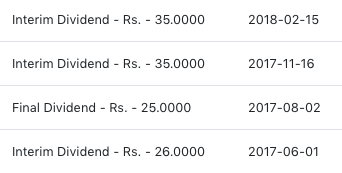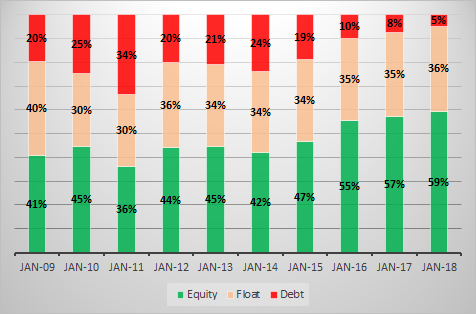Page vs D-Mart - Comparison of two stellar businesses
This might get controversial but I wanted to do this purely from an academic point of view.
D-Mart has a RoE of sub 20% and RoCE of 24% and a CROIC of 29%.
Page has a RoE of 46% and RoCE of 64% and a CROIC of 95%.
(All numbers from Screener)
Both are improving on the metrics where I think D-Mart could get its RoE to 25% levels and Page could be hovering over 50% going forward.
Both are growing at high rates but they are not same.
D-Mart has grown PAT at a scorching 54% CAGR for last 3 years and Page at 21%.
TTM PAT has grown at 46% for D-Mart and 36% for Page which makes things a bit interesting.
So D-Mart is coming off a scorching pace which is moderating while Page has been growing at a steady 20% for over a decade and appears to be accelerating in the near-term. The most recent quarter is stark as Page has grown PAT at 46% while D-Mart has grown at 18%.
If the second-order effect of growth trends were to be plotted, it would appear that this is the year the comparison reaches an inflection point where Page picks up and bypasses D-Mart in terms of growth or at least matches it.
Now coming to reinvestments, it appears like D-Mart will likely reinvest all its retained earnings at a 25% RoE for the foreseeable future, for roughly the same amount of growth while Page will likely reinvest under 50% of its earnings and throw out the rest of the cash as dividends and still maintain that steady, chugging 20-25% CAGR growth at least in the next 5 years. The superior return ratios will ensure Page will invest lesser and lesser of its own money to keep growing, especially with WC improvements where it looks like it will get growth by growing its franchisee EBO network while its RM and WIP Inventory are on outsourced books. In essence, there is a real possibility of Page generating more OCF for its EBITDA than D-Mart as D-Mart may never get to a negative WC scenario while for Page it looks like a possibility.
Now coming to the longevity, both businesses have quite a long runway with large moats. Threats for D-Mart come from e-Commerce which it appears like it can ward off in the near future while for Page, the threats are from other brands but none of Rupa, Lux, Dollar, VIP are anywhere close to dethroning the Jockey brand. It might take a Fruit of the Loom to do that but that’s not a near term threat yet. Page has perhaps an edge here as it has products which won’t become obsolescent anytime soon and appears to also thrive in the e-Commerce space as it is the only underwear brand with a positive cash-flow from e-Commerce sales. It also helps that Page’s products are affordable from a ticket-size perspective.
Now that we have discussed Quality, Growth and Longevity, lets get to the price - purely on a relative basis.
D-Mart trades at 100 P/E and Page at 85 P/E. This delta is what I am trying to wrap my head around. Of course both are insanely expensive by conventional metrics that this write-up itself might sound comical on a forum like this but let’s do this simply as an academic exercise.
Would you pay more for a 20% RoE growing at 40% with a scope for RoE going up to 25% than a 45% RoE company growing at 20% with a scope for RoE going up to 50%? It appears to me that RoE improving from 20% to 25% would probably have a higher impact on valuations than RoE going up from 45% to 50% for the same growth prospects. Maybe this is what the market sees. However, if the growth equation is turned where Page grows at 25% for next 5 years while D-Mart does 20% for the next 5, I think this valuation delta could invert.
Thoughts welcome. This is purely an academic exercise.
 ). Always ending up realizing that one should ‘just buy quality stocks and stay with them for really, really long as long as the growth is intact and the story looks good’. A little bit of valuation here and there does not make a difference if the holding period is very long (as can be seen in the returns from favorite4 over the last 10 years despite buying at PEAK valuations).
). Always ending up realizing that one should ‘just buy quality stocks and stay with them for really, really long as long as the growth is intact and the story looks good’. A little bit of valuation here and there does not make a difference if the holding period is very long (as can be seen in the returns from favorite4 over the last 10 years despite buying at PEAK valuations).
 . The so called poster boy of over valuation /mad valuation did not corrected even -1% after moving 150% up from last year. The message is clear from Mr. Market what general public think about valuation ,he is not agree with that .He is more smart and thinks other way. BTW there was lot of hullabaloos in news channel that HDFC Bank fell below 200 DMA. Hope those analysts got a clue today in market what is HDFC Bank…
. The so called poster boy of over valuation /mad valuation did not corrected even -1% after moving 150% up from last year. The message is clear from Mr. Market what general public think about valuation ,he is not agree with that .He is more smart and thinks other way. BTW there was lot of hullabaloos in news channel that HDFC Bank fell below 200 DMA. Hope those analysts got a clue today in market what is HDFC Bank…







